FIAT Seicento User Manual


Dear New Car Owner
Thank you for selecting Fiat and congratulations on your choice of a Fiat 600.
We have written this handbook to help you get to know all your new Fiat 600’s features and use it in the best possible way.
You should read it right through before taking to the road for the first time.
You will find information, tips and important warnings regarding the driving of the car to help you derive the maximum from your 600’s technical features. You will also find very valuable tips for your own safety, the car’s wellbeing and about how to protect the environment.
The enclosed Fiat Warranty Booklet list the services that Fiat offers its Customers:
•the Warranty Certificate with terms and conditions for maintaining its validity
•the range of additional services available to Fiat Customers.
Best regards and good motoring.
This Owner Handbook describes all the Fiat 600 versions. As a consequence, you should consider only the information which is related to the engine and bodywork version of the car you purchased.
1

MUST BE READ!
REFUELLING
Refuel petrol engine vehicles with unleaded petrol, octane rating (RON) no lower than 95.
KThe use of other products or mixtures may irreparably damage the engine with invalidation of the warranty due to the damage caused.
ENGINE START-UP
Make sure the handbrake is pulled up; put the gear lever into neutral; press the clutch pedal down to the floor without touching the accelerator; turn the ignition key to AVV and release it as soon as the engine starts.
PARKING OVER INFLAMMABLE MATERIAL
When functioning normally, the catalytic converter reaches high temperatures. For this reason do not parkthe vehicle over inflammable material, grass, dry leaves, pine needles, etc.: fire hazard.
PROTECTING THE ENVIRONMENT
A system for continuously monitoring emission system components to ensure greater environmental protec-
Ution is fitted in your vehicle.
2

ELECTRICAL ACCESSORIES
If, after buying the vehicle, you decide to add electrical accessories (that will gradually drain the battery), visita Fiat Dealership. They can calculate the overall electrical requirement and check that the vehicle's electric
system can support the required load.
CODE card
Keep the code card in a safe place, not in the vehicle. You should always keep the electronic code written on the CODE card with you in case you need to carry out an emergency start-up procedure.
SCHEDULED SERVICING
Correct maintenance of the vehicle is essential for ensuring it stays in tip-top condition and safeguards its safety features, its environmental friendliness and low running costs for a long time to come.
THE OWNER HANDBOOK CONTAINS …
… information, tips and important warnings regarding the safe, correct driving of your vehicle, and its maintenance. Pay particular attention to the symbols " (personal safety) # (environmental protection) â (vehicle well-being).
3

SAFE AND ENVIRONMENT-FRIENDLY DRIVING
Safety and respect for the environment are the guidelines inspiring the Fiat 600 project from the beginning. Thanks to its design, 600 has passed extremely strict safety tests. The Fiat 600, from this point of view, is ranked
at the top levels for its class anticipating the parameters of the future.
Moreover, the constant strive towards new and efficient solutions for environmental protection makes your 600 a model to be imitated also from this point of view.
All versions are equipped with environmental-friendly devices which cut down harmful emissions, as per legislation in force.
4 GETTING TO KNOW YOUR CAR
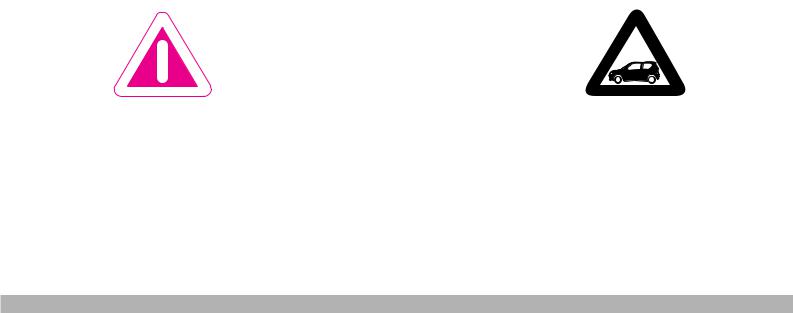
THE SIGNS TO HELP YOU DRIVE CORRECTLY
The signs you see on this page are very important. They highlight those parts of the handbook where, more than anywhere else, you should stop for a minute and read carefully.
As you can see, each sign has a different symbol to make it immediately clear and easy to identify the subjects in the different areas:
|
|
|
|
|
|
|
|
|
|
|
|
|
|
|
|
|
|
Personal safety. |
Protecting the environment. |
The car’s wellbeing. |
||||||
Important: total or partial failure to |
This shows you the correct proce- |
Important. Total or partial failure to |
||||||
follow these instructions can place dri- |
dures to follow to ensure that the car |
follow these instructions will result in |
||||||
ver, passengers or others in serious |
does not harm the environment. |
the risk of serious damage to the car |
||||||
danger. |
|
|
|
and may invalidate the warranty as |
||||
|
|
|
|
|
|
well. |
||
GETTING TO KNOW YOUR CAR |
5 |

GETTING TO KNOW YOUR CAR
SYMBOLS
Special coloured labels have been attached near or actually on some of the components of your Fiat 600. These labels bear symbols that remind you of the precautions to be taken as regards that particular component.
THE FIAT CODE
SYSTEM
To further protect your car from attempted theft, it has been fitted with an electronic engine immobiliser system called “Fiat CODE”, which is automatically activated when the ignition key is removed. The ignition keys, in fact, are fitted with an electronic device that transmits a coded signal to the Fiat CODE control unit; only if this signal is recognised can the engine be started.
The modulated signal is a password. Only if the control unit recognises the key can the engine be started.
The keys fig. 1
The following keys are provided with the car:
–two keys A if the car is not equipped with remote controlled electrical door locking system;
–two keys A and two remote controls B if the car is equipped with remote controlled electrical door locking system.
P4Q00200
fig. 1
6 GETTING TO KNOW YOUR CAR

A - The key with a blue grip is used for:
–starting
–unlocking and locking the doors
–boot tailgate (VAN versions only)
–unlocking and locking the fuel tank cap
–deactivating the passenger side airbag.
B - – Remote control for electrical door locking system.
The CODE card fig. 2 is also supplied with the keys and bears the following:
P4Q00028
fig. 2
–front side:
A - the electronic code to be used for emergency starting;
B - the mechanical key code;
–reverse side:
C - the spaces for any remote control stickers.
Keep the CODE card in a safe place.
Make sure you have the CODE card with you at all times as it is essential if you have to perform an emergency start-up.
U.K. Vehicle only At the behest of the motor Insurance Companies the CODE card for the emergency starting and replacement of keys are not provided. If you need assistance please contact your nearest Fiat Dealership, or telephone Free Phone
0800717000.
DUPLICATING KEYS
When you ask for extra keys, remember that all the keys, both the new ones and those you already possess, must be stored in the memory (up to a maximum of 7). Go to your Fiat Dealership, taking all the keys in your possession and the CODE card with you.
The Fiat Dealership may ask you to demonstrate that you own the car.
The codes of any keys that are not available when the new storage procedure is carried out will be deleted from the memory to prevent any lost or stolen keys being used to start the car.
GETTING TO KNOW YOUR CAR |
7 |

OPERATION
Each time the ignition key is turned to STOP, or PARK, the protection system will automatically immobilise the engine.
When the key is turned to MAR to start the engine:
1)if the code is recognised the ¢ warning light on the instrument panel will flash briefly; this means the protection system has recognised the key code and deactivates the immobiliser, turn the key to AVV, and the engine will start;
2)if the ¢ warning light stays on, the code has not been recognised. In this case, turn the key to STOP position and then turn it back to MAR; if the engine remains immobilised, try with the other keys provided.
If you are still unable to start the engine, use the emergency starting procedure (see IN AN EMERGENCY) and take your car to the nearest Fiat Dealership as soon as possible.
When the car is travelling and the key is at MAR:
1)if the ¢ warning light comes on while the car is moving, this means that the system is running a self-test (e.g. due to a voltage drop);
2)if the warning light ¢ flashes when the key is in MAR the car is not protected by the Immobiliser. Contact your Fiat Dealership and get them to store the codes of all the keys in the memory.
IMPORTANT The electronic components inside the key may be damaged if the key is subjected to sharp knocks.
IMPORTANT Each key provided with the car has its own code, different from all the others, which must be stored in the memory of the system control unit.
All the keys (originals and  duplicates) and the CODE card must be handed over to the new owner
duplicates) and the CODE card must be handed over to the new owner
when selling the car.
8 GETTING TO KNOW YOUR CAR

THE REMOTE
CONTROL
The remote control has a button A- fig. 3 and a led B to turn door locking on; the button activates the control and the led flashes while the transmitter is sending the code to the receiver.
The radio-frequency wave remote control should only be used near the car.
P4Q00030
fig. 3
Ministerial homologation
In accordance with the legislation covering radio frequencies in force in each country, we should like to point out that:
–the market-specific homologation numbers are listed at the back of this handbook (homologation fiche are provided for some countries);
–in markets requiring transmitter marking, the transmitter code is printed on the remote control.
P4Q00031
fig. 4
REPLACING THE BATTERIES fig. 4
If when the remote control button is pressed the doors are not locked/unlocked or the performed operation signal (indicator lights on) does not appear, change the battery, using spare batteries of the same kind, as follows:
1)open the plastic shells using the tip of a screwdriver inserted in the ring groove indicated in figure;
2)insert a new battery B respecting the polarity;
3)close the plastic shells.
Used batteries pollute  the environment. Dispose of them in the special containers as specified by current legislation or take them to your nearest Fiat Dealership, which
the environment. Dispose of them in the special containers as specified by current legislation or take them to your nearest Fiat Dealership, which
will deal with their disposal.
GETTING TO KNOW YOUR CAR |
9 |

SEAT BELTS
USING THE SEAT BELTS
The belt should be worn keeping the chest straight and rested against the seat back.
Take hold the tongue B-fig. 5 and insert it into the buckle C, until hearing the locking click.
If it jams, let it rewind for a short stretch, then pull it out again without jerking.
To unfasten the seat belts, press button D. Guide the seat belt with your hand while it is rewinding, to prevent it from twisting.
Do not press button D when running.
Through the reel, the belt automatically adapts to the body of the passenger wearing it, allowing freedom of movement.
When the car is parked on a steep slope the reel mechanism may block; this is normal. The reel mechanism prevents the webbing coming out when it is jerked or if the car brakes sharply, as in a collision or when cornering at high speed.
The rear seat is fitted with inertial seat belts with three anchor points and reel.
CENTRAL REAR SEAT
For versions /markets where applicable the centre seat, if any, is fitted with lap belt with two anchor points.
P4Q01060 |
P4Q01074 |
P4Q01075 |
fig. 5 |
fig. 6 |
fig. 6a |
10 GETTING TO KNOW YOUR CAR

In order to ensure that the correct tabs are fitted into the corresponding buckle, the tabs of the side belt and the buckle of the centre seat (only abdominal) are incompatible.
The rear seat belts shall be worn as shown in figure 6. Figure 6a shows
wrong seat belt fastening, not to be followed.
Remember that in the case of violent collision, back seat passengers not
wearing seat belts also represent a serious danger to the front passengers.
ADJUSTING THE SEAT BELT HEIGHT
There are two anchoring positions A and B-fig. 7 for front seat belts on the door post.
Before driving off for the first time, adjust the position of the seat belt anchoring point according to your height and favourite driving position. If required, have the anchoring point of the seat belt adjusted.
IMPORTANT Have this operation performed at a Fiat Dealership only as it involves passenger safety.
USING THE CENTRAL REAR SEAT BELT
(For versions/markets)
To fasten the seat belt: push the fastener tongue A-fig. 7a into slot B of the buckle, until you hear it click.
To unfasten the seat belt: press button C.
To adjust the belt: slide the webbing through D, pulling length E to tighten and length F to loosen.
IMPORTANT The belt is adjusted properly when it fits closely across the hips.
P4Q00018 |
|
P4Q00037 |
|
|
|
fig. 7 |
fig. 7a |
GETTING TO KNOW YOUR CAR |
11 |

PRETENSIONERS
To increase the efficiency of the front and rear (where provided) seat belts, the Fiat Panda is fitted with pretensioners. These devices “feel”, through a sensor, that a violent crash is in progress and rewind the seat belts a few centimetres. In this way they ensure that the seat belt adheres perfectly to the wearer before the restraining action begins.
The seat belt locks to indicate that the device has intervened; the seat belt cannot be drawn back up even when guiding it manually.
IMPORTANT To obtain the highest degree of protection from the action of the pretensioning device, wear the seat belt keeping it firmly close to the chest and pelvis.
A small amount of smoke may be produced. This smoke is in no way toxic and presents no fire hazard.
The pretensioner does not require any maintenance or greasing. Anything that modifies its original conditions invalidates its efficiency. If due to unusual natural events (floods, sea storms, etc.) the device has been affected by water and mud, it must necessarily be replaced.
The pretensioner can only be used once.
After a collision that has triggered it, have it replaced at a Fiat Dealership. The validity of the device is written on the plate located on the front left door post. The pretensioners should be replaced at a Fiat Dealership as this date approaches..
12 GETTING TO KNOW YOUR CAR
Operations which lead |
to knocks, vibrations or |
localised heating (over |
100°C for a maximum of 6 |
hours) in the area around the |
pretensioners may cause damage |
or trigger them. These devices |
are not affected by vibrations |
caused by irregularities of the |
road surface or low obstacles |
such as kerbs, etc. Contact a Fiat |
Dealership for any assistance. |
10090807 |
04030201 |
20182017 |
PRETENSIONERS |
20152014 |
05040306 |
11100912 |
P4Q00226 |
|
|
|
|
|
|
|
|
|
|
AIRBAG |
AND |
|
|
|
|
12 11 |
06 05 |
2019 |
CLOCK SPRING |
2013 |
01 02 |
07 08 |
|
|
|
ATTENZIONE:
CAUTION:
ATTENTION:
ACHTUNG:
fig. 7b
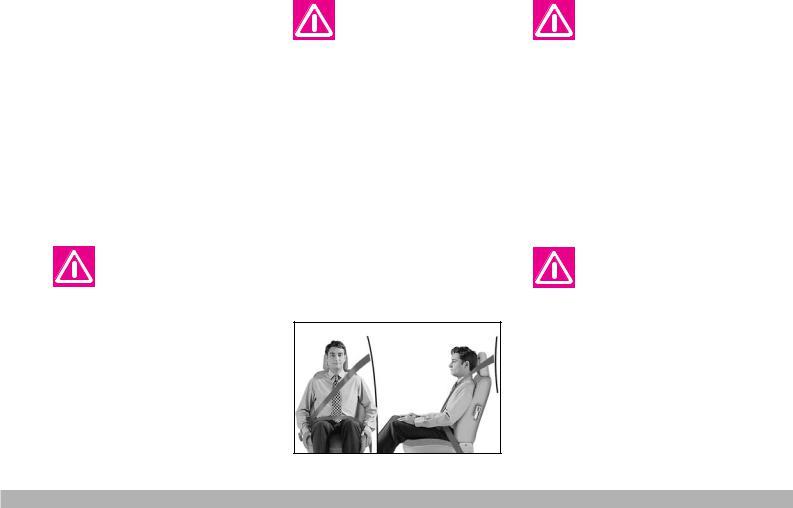
GENERAL INSTRUCTIONS FOR USING THE SEAT BELTS
The driver must comply with (and have the vehicle occupants follow) all the local legal regulations concerning the use of seat belts.
Always fasten the seat belts before starting driving.
The belt should not be twisted, make sure that it is taut and adheres to the
passenger’s body. The upper part should pass over the shoulder and cross the chest diagonally. The lower part should adhere to the pelvis and to the abdomen of the passenger, to prevent the risk of slipping forwards, fig. 8. Do not use any objects (pegs, stoppers, etc.) to keep the belts away from the body.
Under no circumstances should the components of the pretensioner be
tampered with or removed. Any operation should be carried out by qualified and authorised personnel. Always contact a Fiat Dealership.
For maximum safety, keep the back of your seat upright, lean back
into it and make sure the seat belt fits closely across your chest and hips.
Make sure that the seat belts of the front and rear passengers are fastened at all times! You increase the risk of serious injury or death in a collision if you travel with the belts unfastened.
fig. 8
P4Q00038
If the belt has been subjected to heavy stress, for example after an accident, it should be changed com-
pletely together with the anchors, anchor fastening screws and the pretensioners. In fact, even if the belt has no visible defects, it could have lost its resilience.
GETTING TO KNOW YOUR CAR |
13 |
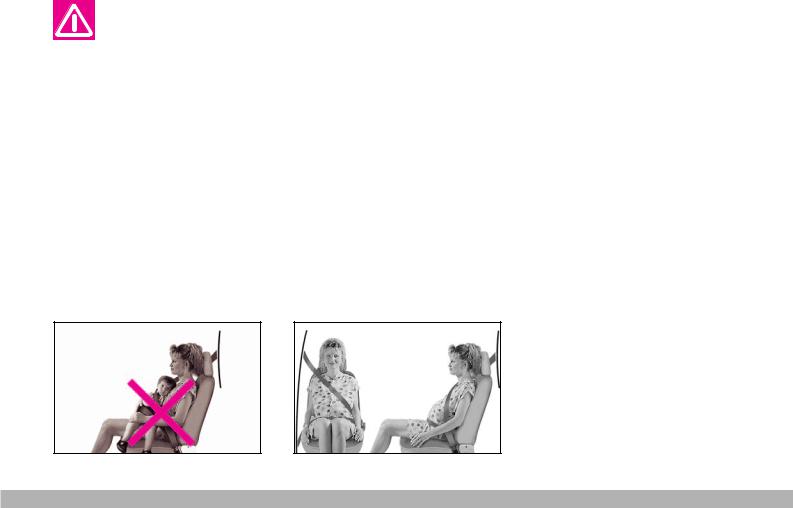
Never travel with a child sitting on the passenger’s lap with a single belt to
protect them both fig. 9 and do not fasten other objects.
P4Q00039
fig. 9
Seat belts are also to be worn by expectant mothers: the risk of injury in the case of accident is greatly reduced for them and the unborn child if they are wearing a seat belt.
Of course they must position the lower part of the belt very low down so that it passes under the abdomen fig. 10.
P4Q00040
fig. 10
HOW TO KEEP THE SEAT BELTS ALWAYS IN EFFICIENT CONDITIONS
1)Always use the belt with the tape taut and never twisted; make sure that it is free to run without impediments.
2)After a serious accident, replace the belt being worn at that time, even if it does not appear damaged. Always replace it in case of pretensioner activation.
3)To clean the belts, wash by hand with neutral soap, rinse and leave to dry in the shade. Never use strong detergents, bleach or dyes or other chemical substance that might weaken the fibres.
4)Prevent the reels from getting wet: their correct operation is only guaranteed if water does not get inside.
5)Replace seat belt if showing wear or cut signs.
14 GETTING TO KNOW YOUR CAR

CARRYING CHILDREN SAFELY
For optimal protection in the event of a crash, all passengers must be seated and wearing adequate restraint systems.
This is even more important for children.
According to 2003/20/EC Directive, this prescription is compulsory for all European Community countries.
Compared with adults, their head is proportionally larger and heavier than the rest of the body, while the muscles and bone structure are not completely developed. Therefore, correct restraint systems are necessary, other then adult seat belts.
The results of research on the best child restraint systems are contained in the European Standard ECE-R44. This Standard enforces the use of restraint systems classified in five groups:
Group 0 - 0-10 kg in weight
Group 0+ - 0-13 kg in weight
Group 1 9-18 kg in weight
Group 2 15-25 kg in weight
Group 3 22-36 kg in weight
All restraint devices must bear the certification data, together with the control brand, on a solidly fixed label which must absolutely never be removed.
Over 1.50 m in height, from the point of view of restraint systems, children are considered as adults and wear the seat belts normally.
Lineaccessori Fiat offers seats for each weight group, which are the recommended choice, as they have been designed and experimented specifically for Fiat cars.
F0C1076b
fig. 11
GETTING TO KNOW YOUR CAR |
15 |

SERIOUS DANGER: Never place cradle child’s seats on

 the front passenger seat of cars fitted with passenger’s air bag. The air bag activation could cause serious injuries, even mortal. You are advised to carry children always on the rear seats,
the front passenger seat of cars fitted with passenger’s air bag. The air bag activation could cause serious injuries, even mortal. You are advised to carry children always on the rear seats,
as this is the most protected position in the case of a crash. In any case, children’s seats must absolutely not be fitted on the front seat of cars with passenger’s air bag, which during inflation could cause serious injury, even mortal, regardless of the seriousness of the crash that triggered it. Children may be placed on the front seat of cars fitted with passenger’s air bag deactivation. In this case, it is absolutely necessary to check the warning light F on the cluster to make sure that deactivation has actually taken place (see paragraph “Passenger’s front air bag” at item “Front air bags”). The front passenger’s seat shall be adjusted in the most backward position to prevent any contact between child’s seat and dashboard.
GROUPS 0 and 0+
Babies up to 13 kg must be carried facing backwards on a cradle seat, which, supporting the head, does not induce stress on the neck in the event of sharp deceleration.
The cradle is restrained by the car seat belts, as shown in fig. 12 and in turn it must restrain the child with its own belts.
The figure is only an example for mounting. Attain to the instructions
for fastening which must be enclosed with the specific child restraint system you are using.
P4Q01077
fig. 12
16 GETTING TO KNOW YOUR CAR

GROUP 1
Starting from 9 kg to 18 kg in weight, children may be carried facing forwards, with seats fitted with front cushion fig. 13, through which the car seat belt restrains both child and seat.
The figure is only an example for mounting. Attain to the instructions
for fastening which must be enclosed with the specific child restraint system you are using.
P4Q01078
fig. 13
Seats exist which are suitable for covering weight groups 0 and 1 with a rear connection to the car
belts and their own belts to restraint the child. Due to their size, they can be dangerous if installed incorrectly fastened to the car belts with a cushion. Carefully follow the instructions for installation provided with the seat.
GROUP 2
Starting from 15 kg to 22 kg in weight, children may be restrained directly by the car belts. The only function of the seat is to position the child correctly in relation to the belts, so that the diagonal part adheres to the chest and not to the neck and that the horizontal part clings to the child’s pelvis and not the abdomen fig. 14.
The figure is only an example for mounting. Attain to the instructions
for fastening which must be enclosed with the specific child restraint system you are using.
P4Q01079
fig. 14
GETTING TO KNOW YOUR CAR |
17 |

GROUP 3
Starting from 22 kg to 36 kg in weight, the size of the child’s chest no longer requires a support to space the child’s back from the seat back.
Fig. 15 shows an example of proper child positioning on the rear seat.
Children taller than 1.50 m can wear seat belts like adults.
PASSENGER SEATS
COMPLIANCE WITH REGULATIONS ON CHILD’S SEAT USE
Fiat 600 complies with the new 2000/3/EC Directive regulating child’s seat assembling on the different car seats according to the table on next page.
Key for the table on next page.
U = suitable for child restraint systems of the “Universal” category, according to European Standard ECE R44 for the specified “Groups”.
(*)No child’s seat can be installed on the rear seat with lap belt (without reel).
P4Q01080
Group |
Range |
Front |
Rear side |
Central |
|
of weight |
passenger |
passenger |
Rear side |
|
|
|
|
passenger |
|
|
|
|
(if any) |
Group 0, 0+ |
up to 13 kg |
U |
U |
(*) |
Group 1 |
9-18 kg |
U |
U |
(*) |
Group 2 |
15-25 kg |
U |
U |
(*) |
Group 3 |
22-36 kg |
U |
U |
(*) |
fig. 15
18 GETTING TO KNOW YOUR CAR

Below is a summary of the rules of safety to be followed for carrying children:
1) The recommended position for installing children’s seat is on the rear seat, as it is the most protected in the case of a crash.
Never fit child restraint systems in the front passenger seat in cars with passenger airbag, children must
never be seated on front seats.
2)If the passenger’s air bag is deactivated always check the warning light F on the cluster to make sure that it has actually been deactivated.
3)Attain to the instructions for fastening the specific child restraint system which you are using. These instructions must be provided by the manufacturer. Keep the child restraint system installation instructions with the car documents and this Handbook. Never use a child restraint system without installation instructions.
4)Always check the seat belt is well fastened by pulling the webbing.
5)Only one child is to be strapped to each retaining system.
6)Always check the seat belts do not fit around the child’s throat.
7)While travelling, do not let the child sit incorrectly or release the belts.
8)Passengers should never carry children on their laps. No-one, however strong they are, can hold a child in the event of a crash.
9)In case of an accident, replace the seat with a new one.
GETTING TO KNOW YOUR CAR |
19 |
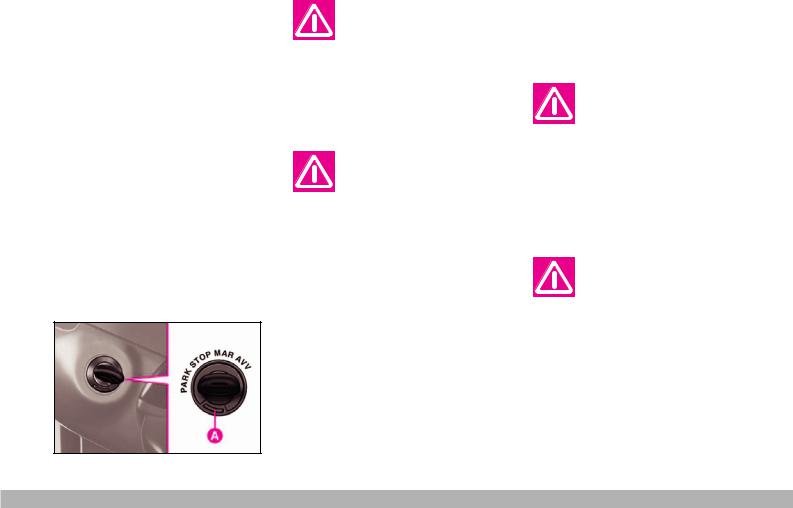
IGNITION SWITCH
The key can be turned to four different positions fig. 16.
–STOP: engine off, key can be removed and the steering column is locked mechanically. Some electrical devices can be used (e.g. sound system).
–MAR: drive position. All electrical devices can be used.
–AVV: engine ignition.
–PARK: engine off, parking lights on, steering column locked. Press button A and turn the key to PARK.
P4Q00004
fig. 16
If the ignition switch has been tampered with (e.g. someone has tried to steal your car), get a Fiat Deal-
ership to make sure it is still functioning properly before you start driving again.
Always remove the ignition key when you get out of the car. This will
prevent anyone from accidentally working the controls. Remember to apply the handbrake and, if the car is faced down on a steep slope engage the first gear. If it is facing up, engage the reverse gear.
STEERING COLUMN LOCK
To engage the lock: remove the ignition key at STOP or PARK and turn the steering wheel until it locks.
To release the lock: rock the steering wheel slightly as you turn the ignition key to MAR.
Never remove the ignition key while the car is moving. The steering wheel would automatically lock
as soon as you try to turn it. This also applies when the car is being towed.
It is absolutely forbidden |
to carry out whatever af- |
ter-market operation in- |
volving steering system or steer- |
ing column modifications (e.g.: in- |
stallation of anti-theft Device) |
that could badly affect perfor- |
mance and safety, cause the lapse |
of warranty and also result in |
non-compliance of the car with |
homologation requirements. |
20 GETTING TO KNOW YOUR CAR
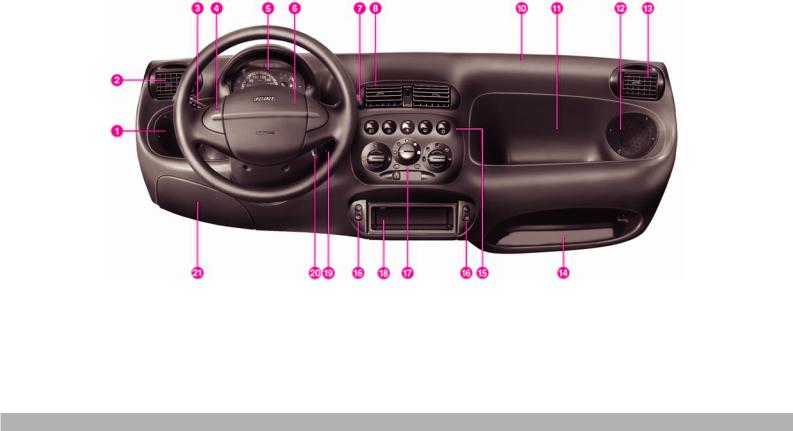
DASHBOARD
Left-hand drive versions
The presence and position of the instruments and warning and indicator lights may vary according to the version of the car.
fig. 17
P4Q00225
1. Left speaker housing - 2. Side window defroster/demister vents - 3. External light control stalk - 4. Horn - 5. Instrument panel - 6. Steering wheel and airbag - 7. Windscreen/rear window wiper/washer control stalk - 8. Central air vents - 10. Windscreen defroster/demister vents - 11. Oddment compartment - 12. Right speaker housing - 13. Side window defroster/demister vents - 14. Oddment compartment under dashboard - 15. Control buttons - 16. Electric window controls - 17. Heating and ventilation controls - 18. Sound system housing/oddment compartment - 19. Headlight adjustment control - 20. Ignition switch - 21. Fusebox.
GETTING TO KNOW YOUR CAR |
21 |
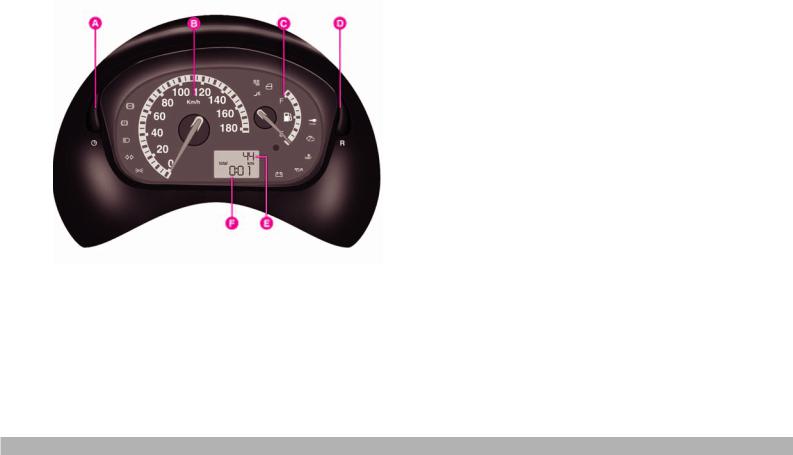
INSTRUMENT PANEL
A. Clock setting button
B. Speedometer
C. Fuel level gauge
D. Trip meter reset button
E. Kilometre or mileage counter
F. Clock.
P4Q01004
fig. 18
22 GETTING TO KNOW YOUR CAR

INSTRUMENTS
SPEEDOMETER COUNTER fig. 19
A - Kilometre counter.
B - Speedometer.
C - Trip meter reset button. Press to reset fig. 20.
P4Q01006
Press briefly = switch from kilometre counter to trip meter and vice versa.
Press longer = reset trip meter.
D - Kilometre counter display fig. 20.
P4Q01009
FUEL LEVEL GAUGE
When the reserve warning light comes on A-fig. 21 there are still about 7 litres of fuel in the tank.
E - tank empty.
F - tank full (see the indications given in paragraph “At the filling station").
Do not travel with the fuel tank almost empty: the gaps in fuel delivery could damage the catalyser.
P4Q00228
fig. 19 |
fig. 20 |
fig. 21 |
GETTING TO KNOW YOUR CAR |
23 |
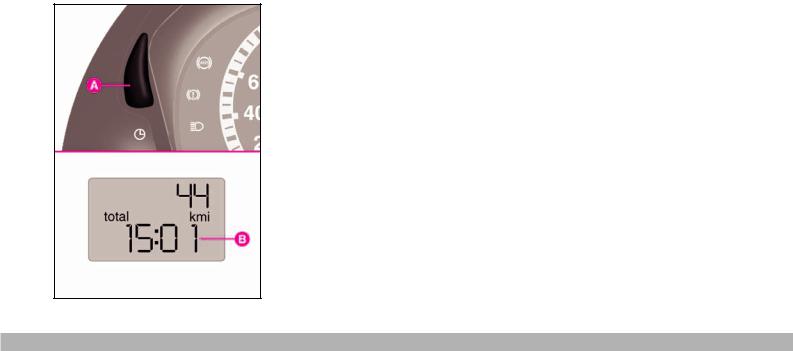
CLOCK
B-fig. 22 Clock display.
To adjust the time press A-fig. 22.
P4Q01056
fig. 22
The clock will advance by one unit each time the button is pressed. Press the button and hold it down for a few seconds to rapidly advance the time automatically.
When the clock draws near to the correct time, release the button and complete the regulation manually.
CUT-OFF SWITCH ON DISPLAY fig. 23
The display shown appears automatically when the inertial fuel cut-off switch cuts in, following a crash of a certain magnitude.
The switch shuts off the supply of fuel.
IMPORTANT See the description in the CONTROLS paragraph under IN-
ERTIAL FUEL CUT-OFF SWITCH.
24 GETTING TO KNOW YOUR CAR
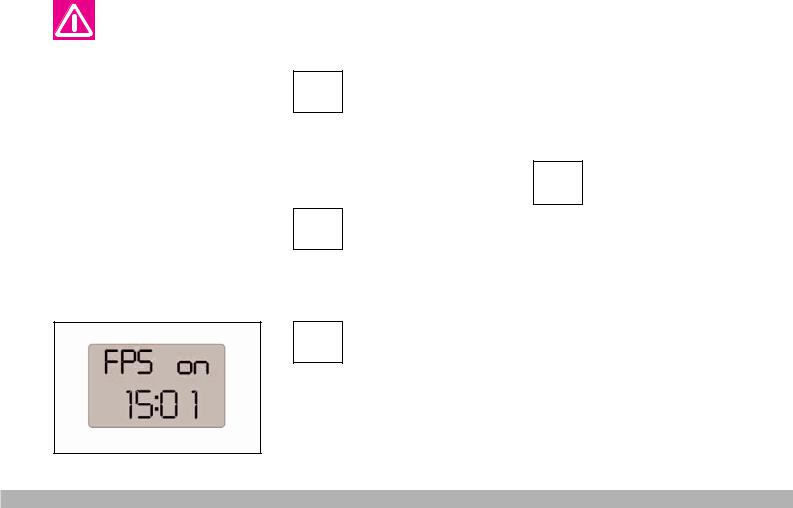
If after the display of the message the smell of fuel or leaks from the supply
system are noted,do not re-en- gage the switch to avoid the risk of fire.
WARNING LIGHTS
These warning lights will come on in the following cases:
DIRECTION y INDICATORS
(flashing) (green)
When the direction indicator control stalk is operated.
P4Q01058
fig. 23
EXTERNAL LIGHTS 3 (green)
When the side/taillights are switched on.
lTRAILERDIRECTION
INDICATORS
(IF ANY) (green)
When the direction indicator control stalk is operated.
1 |
MAIN BEAM |
HEADLIGHTS (blue) |
|
|
|
When the main beam headlights are turned on.
>LOCKING SYSTEMWHEEL ANTI-
(ABS) FAILURE
(amber)
The normal braking system continues to work but you should have the car seen to at a Fiat Dealership. When the key is turned to MAR the warning light will come on but should go out after about 2 seconds.
GETTING TO KNOW YOUR CAR |
25 |

The car is fitted with an |
electronic braking device |
(EBD). The > and x |
warning light will come on at the |
same time when the engine is |
running to indicate that there is |
an EBD system failure. In this |
case violent braking may be ac- |
companied by early rear wheel |
locking with the possibility of |
skidding. Drive the car extremely |
carefully to the nearest Fiat Deal- |
ership to have the system |
checked. |
Warning light > alone, with the engine running, normally indicates a fault in the ABS system only. In this
case, the braking system is still efficient, though without the anti-locking device. Under these conditions, performance of the EBD system may be reduced. Also in this case, you are advised to go immediately to the nearest Fiat Dealership, driving in such a way to avoid sharp braking to have the system checked.
FUEL RESERVE
K (amber)
When there are about 7 litres of fuel left in the tank.
F PASSENGER SIDE
AIRBAG OFF (amber)
The warning light will come on when the passenger side airbag is switched off.
The light will flash when the engine is started: this signals the airbag is being activated and not a fault.
Warning light F indicates also warning light ¬ failure. This is indi-
cated by intermittent flashing, over 4 seconds, of warning light F. In this event, warning light ¬ could be not up to indicate restraint system failures, if any. Stop the car and contact Fiat Dealership to have the system checked.
26 GETTING TO KNOW YOUR CAR
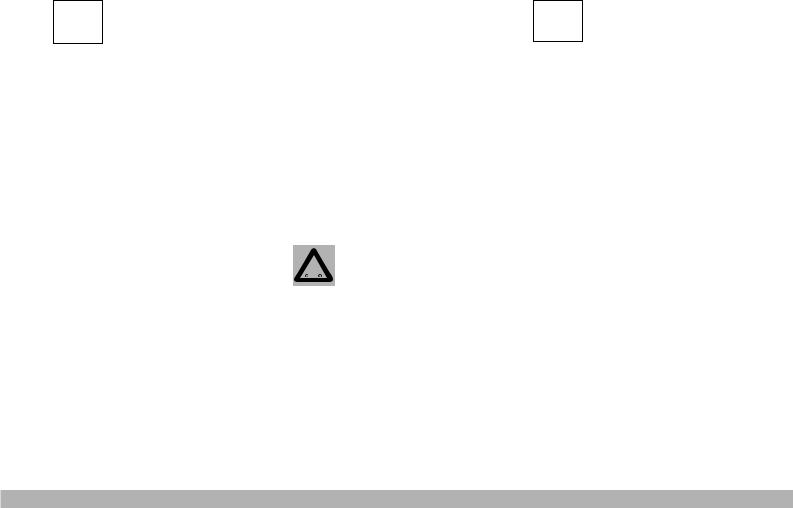
USYSTEM FAILURE (EOBD) (amber)ENGINE CONTROL
In normal conditions, the warning light will come on when the ignition key is turned to MAR and should go out as soon as the engine is started. The initial lighting up shows that the warning light is working properly.
If the warning light either stays on or comes on while travelling:
1. Fixed light - warning of a fuel feed/ignition system failure which may increase emissions in exhaust or cause possible drops in performance, poor handling and high consumption.
In such conditions, you can continue driving but you should not tax the engine and you should moderate the speed. Prolonged use with the warning light on can cause damage. Contact a Fiat Dealership as soon as possible.
The warning light will go out when the failure disappears. In any case, the system will store the error.
2. Flashing - warning that the catalyser can be damaged (see EOBD SYSTEM in this chapter).
If the warning light starts flashing, release the accelerator pedal and slow the engine until the warning light stops flashing. Continue driving at moderate speed, preventing the warning light from coming on again. Contact a Fiat Dealership as soon as possible.
Contact a Fiat Dealer-  ship as soon as possible if the U warning light either does not come on when the
ship as soon as possible if the U warning light either does not come on when the
key is turned to MAR or comes on, with fixed or flashing light, when travelling.
FIAT CODE ¢ (amber)
The warning light will come on the three cases when the key is at MAR:
1.Single flash - indicates that the key code has been recognised. The engine can be started.
2.Fixed light - the key code has not been recognised. Follow the emergency procedure to start the engine
(see IN AN EMERGENCY).
3.Flashing light - indicates that the car is not protected by the immobiliser system. The engine can however be started.
GETTING TO KNOW YOUR CAR |
27 |
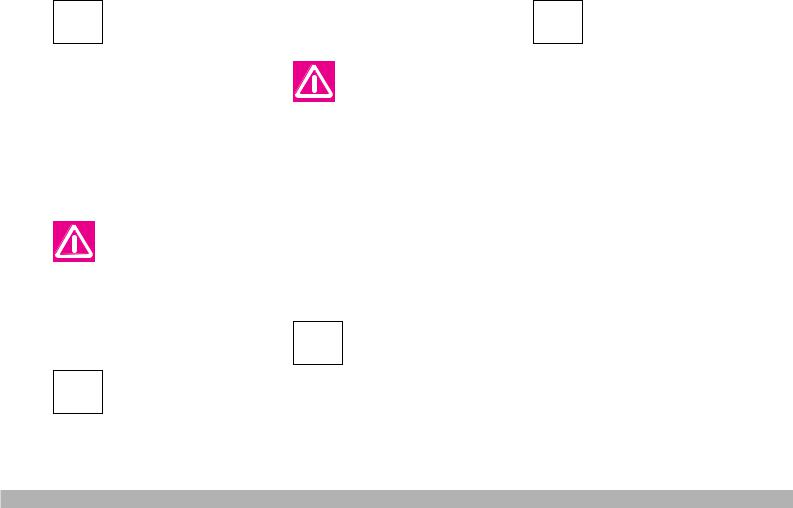
xENGAGED / LOW BRAKE FLUIDHANDBRAKE
LEVEL (red)
In three cases:
1.When the handbrake is engaged.
2.When the brake fluid level falls below the minimum
3.With the > warning light to indicate an EBD electronic brake force corrector failure.
If the x warning light comes on when travelling, check whether the
handbrake is engaged. If the warning light stays on and the handbrake is not engaged, stop immediately and contact a Fiat Dealership.
û |
AIRBAG |
FAILURE |
(red) |
|
This warning light is found in cars fitting two airbags (driver’s side and passenger’s side) and in cars fitting an electronic driver’s side
airbag system. The warning light will come on to indicate a system failure.
If the ¬ warning light does not turn on when turning the ignition key to MAR or if it stays on when
travelling, this could indicate a failure in safety retaining systems; under this condition air bags or pretensioners could not trigger in the event of collision or, in a restricted number of cases, they could trigger accidentally. Stop the car and contact Fiat Dealership to have the system checked immediately.
BATTERY NOT w RECHARGING
PROPERLY (red)
When there is a fault in the current generating system.
When the key is turned to MAR the light comes on but should go out the moment the engine is started.
gELECTRICAL POWER STEERING FAILURE (red)
In the following two cases:
1 - When the power steering electrical motor is overheated by repeated, complete steering. In this case, hold the steering wheel still and wait for the light to go out.
2 - When there is an electrical power steering system failure.
When the key is turned to MAR the warning light should come on for approximately four seconds only. If the warning lights stays on, the power steering system will not be working. The effort on the steering wheel will increase without compromising steerability. Contact a Fiat Dealership.
28 GETTING TO KNOW YOUR CAR
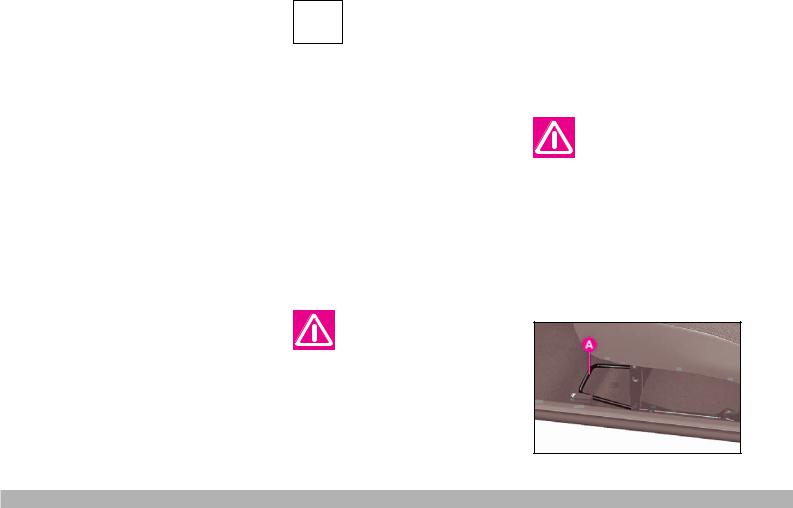
u |
ENGINE COOLANT |
TOO HOT |
|
|
(Red) |
|
Turning the ignition key to MAR the warning light turns on, but it should go off after four seconds.
If it turns on when travelling, stop the car, leaving the engine on and slightly accelerated to further activate the circulation of the coolant fluid.
If the warning light does not go off within the next 2 or 3 minutes, stop the engine and contact Fiat Dealership.
ENGINE OIL
vPRESSURE TOO LOW (red)
When the engine oil pressure drops under the normal value.
When the key is turned to MAR, the warning light should come on but should go out as soon as the engine is started.
A delay in the light going out is acceptable only when the engine is idling.
If the engine has been taxed heavily, the light might flash when idling but should go out on accelerating slightly.
If the warning light comes on while the car is moving, stop the engine
and contact a Fiat Dealership.
INDIVIDUAL
SETTINGS
FRONT SEATS
All adjustments must be made when the car is stationary.
Moving the seat backwards or forwards
Lift the lever A-fig. 25 and push the seat forwards or backwards. You are in the correct position for driving when your hands are resting on the steering wheel rim and your arms are slightly bent.
P4Q00005
fig. 25
GETTING TO KNOW YOUR CAR |
29 |
